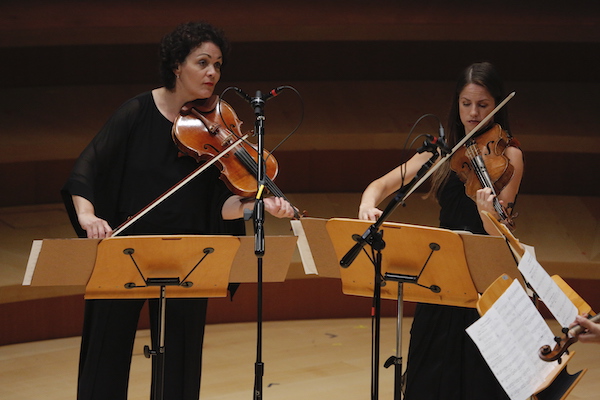New World’s Viola Festival off to a racing start

Few instruments get less respect than the viola.
This stepchild of the violin often plays inner lines in orchestral works, seldom getting to sound the major thematic material. Both the instrument and its players are frequently the subject of jokes.
With its “Viola Visions” festival, the New World Symphony aims to change all that. The first installment of an annual series devoted to an individual instrument, this week-long event has gathered some of the world’s finest exponents of the instrument, present and former New World fellows and students from local schools for a deep immersion into mostly seldom heard repertoire that displays the viola’s artistic possibilities.
“Three Centuries and Counting,” the festival’s opening concert on Wednesday night at the New World Center, led by Michael Tilson Thomas proved an exhilarating exploration of historic and contemporary viola scores.
The world premiere of Concerto for Viola Ensemble by Nils Bultmann, an NWS commission, was an exciting opener. A former New World fellow and freelance player active in jazz, film and dance projects as well as classical performances in the San Francisco Bay area, Bultmann conceived a modern concerto grosso that mixes neo-Baroque twists with minimalism. Scored for 30 players, including a core group of four viola soloists, the nine-minute score’s layered textures and harmonics exploit writing for the viola’s highest and lowest ranges, with a motoric fragments finale that rushes to a dynamic and rousing conclusion. This appealing work is a winner for both the audience and instrument.
Bultmann, FIU professor Michael Klotz (of the Amernet Quartet), Erik Rynearson (principal violist of the Los Angeles Chamber Orchestra) and Madeline Sharp (from the Atlanta Symphony) articulated the difficult solo writing with agile brilliance. They were surrounded by an ensemble of school students and New World fellows who played with unanimity and silken tone.
Bach’s Brandenburg Concerto No. 6 in B-flat Major may be familiar literature but it was given a slimmed-down rendition. Instead of a larger group of players, just two violists (one to a part) were joined by two cellos, two viola da gambas (the cello’s forerunner), double bass and harpsichord. Soloists were the New York Philharmonic’s longtime principal viola Cynthia Phelps and San Francisco Symphony first chair Jonathan Vinocour. It was fascinating to hear the difference between the tonal warmth of Phelps’ classic 1560 Gasparo de Saló instrument and the darker timbre of Vinocour’s modern 2014 viola.
The soloists favored crisp tempos and strong rhythmic accents. Rarely has the first movement been played with such accuracy and transparency of voices. The noble melody of the Adagio was shaped with spaciousness. The final Allegro seemed to dance off the strings, vigorous and filled with rustic high spirits. Michael Beattie was an unobtrusive tower of strength at the harpsichord continuo. Cellist Alan Okhubo, viola da gambists Caroline Nicolas and Arnie Tanimoto and Douglas Aliano on bass were strong and secure in support.
The familiar “La Folia” theme has been the basis of numerous compositions across the centuries but Irish violist-composer Garth Knox puts it through some fresh musical hoops in his Marin Marais Variations for four violas. While some sections adhere closely to the stately melody, Knox’s sense of wit encompasses hazy drones, tapping and brushing the bow on the instruments’ strings and wood and leaps into atonality. With crisscrossing country fiddling, minimalist strokes and the opulent sound of a film score, Knox’s 11- minute divertissement is great entertainment.
In an evening of superb viola playing, Tabea Zimmermann was first among equals. As the lead player, her magisterial phrasing, total mastery of Knox’s wild instrumental gymnastics and depth of tone were unique in artistic individuality. New World players Stephanie Block, Jessica Pasternak and Kip Riecken, matched Zimmermann’s expressive intensity.
Andrew Norman wrote Gran Turismo as a student, inspired by dorm partners with a fondness for the title car racing video game. Originally conceived for violins, Norman’s new version for eight violas certainly puts the players through their paces in a display of speed and sheer agility.
As an accompaniment to a game or film of a race, Norman’s score would perfectly capture the frantic aura but his punchy thematic fragments and sudden stops quickly wear thin as a concert piece. Still it is an awesome technical challenge and chamber player, concert producer and broadcaster Nadia Sirota led a dazzling traversal that met Norman’s hurdles on their own terms. Sharp, Anthony Parce, Rynearson, Yuan Qi, Spencer Ingersoll, Daniel Fellows and Marlea Simpson all reached the finish line in winning fashion. The New World’s “Viola Visions” expo is certainly off and running.
The New World Symphony presents “Visions and Installations” with guest violists Nadia Sirota, Tabea Zimmermann, Matthew Lipman, Jonathan Vinocour and Kim Kaashkashian and composer-conductor Nico Muhly playing works by Muhly, George Benjamin, Luciano Berio and Betty Olivero 8 p.m. Thursday at the New World Center in Miami Beach. nws.edu; 305-673-3331 All “Viola Visions” events are being streamed on the New World Symphony Facebook page, the Violin Channel and Medicitv.
Posted in Performances
Leave a Comment
Thu Oct 17, 2019
at 11:36 am
No Comments
